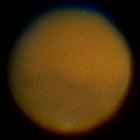
Mars unprocessed image |
Planet Imaging Processing & Astro Artistry 2
September 2003
|
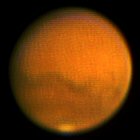
Mars processed image
|
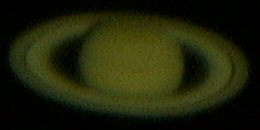
Saturn unprocessed image |
|

Saturn processed image
|
Astro artistry is the personal preference of processing and presenting the image.
Images can be processed for maximum details or processed for a pleasing image.
This is a typical imaging processing procedure I have been using on planets such as
Mars and
Saturn with the Philps ToUcam web camera as of September 2003.
The challenge in imaging the planets is the long focal lengths needed for good image details and the affects of seeing.
Fast exposure times help to reduce some of the affects of seeing.
But, fast exposures result in dim, noisy and low contrast images as seen in the above single unprocessed image of Mars.
Imaging processing improves the signal to noise by stacking (combining) multiple good images into one processed image.
The above Mars images show a single image and the result of
combining and processing 128 images into one image.
These images are a small 140 x 140 sub frame of the
complete 640 x 480 resolution of the Philps ToUcam web camera.
Imaging Equipment
- Camera: Philips ToUcam
- Telescope: Orion Atlas 10 reflector (254 mm aperture,
f/4.7 focal ratio, 1200 mm focal length)
- Barlow: Tele Vue 5x Powermate (effective f/23.5 focal ratio, 6000 mm focal length)
- Finder: Mounted on top of a Atlas 10 is an Orion ShortTube™ 80 mm aperture rich-field refractor
(f/5 focal ratio, 400 mm focal length) which is used as a finder.
- Telescope Mount: Losmandy G-11 mount
Mars Image Information
- South pole is at the bottom
- 128 images stacked out of 1400
- Images taken at 1/33 second
- Good seeing
- 2003/9/25 10:47 AM PDT
- Images taken from driveway
Software Used
- Cor Berrevoets RegiStax Version 2.1.13 Beta align, select, stack and process
- JASC Inc. Paint Shop Pro Version 8.01, unsharp mask, curves, crop and convert to JPG
Setup directories and sort files
- Create an image work in progress directory (WIP) and a Processed directory in WIP directory.
- Copy the Philps ToUcam web camera AVI file to the WIP directory.
Process AVI File with RegiStax
RegiStax processing includes four major steps: Input, Aligning, Stacking and Wavelet Processing.
RegiStax Input Processing
- Select Input AVI file to process
- Select Save to subdir for processed images
- No darkframes or flatfields are used because of the short exposure times
- Set Color processing
- Set Processing Area to 512
- Set Alignment to 256
- Point to center of planet to set alignment box
RegiStax Aligning Processing
- Set alignment filter well to the right of the middle of bend in the curve
- Set quality filter band about .15
- Resample at 2X using Mitchell
- Auto-optimization on
- Fast optimize off
- Manual alignment off
- Optimizing options (optimize until 1%, Search area 4 pixels, lower quality 0%)
- Tracking option (Track object on, Misalign warning on)
- Start the aligning process
RegiStax Stacking Processing
- Color processing on
- Show stack list and check image quality.
For short exposures like 1/100 second with high noise it is common to have to uncheck noisy bad images in top part of the stack list.
- Select number of images to stack, see botton of this web page for examples of different stacking examples.
RegiStax Wavelet Processing
- Select Linear Wavelet Scheme
- Adjust Step size, it common to have step size of 2 or 3 for low noise images. Step size of 2 was use below.
- Layer values of 1, 20.6, 30, 30, 30, 30 were used for Wavelet Processing (noisy images).
- Layer values of 1, 20.6, 40.8, 40.1, 40.8, 40.1 were used for strong Wavelet Processing.
- Select Process
- Do all is only necessary for image larger than the processing area (like Saturn)
- Set RGB shift and run Estimate
- Set Gamma Curve to .7
- No changes to contrast and Brightness
- Save image at 2X as BMP,
- Resize to 50% using Lanczos and save 1X image as BMP
(note resize original size will not produce the original 640x480, but 50% will)
- Save project
RegiStax Wavelet Processing Image Summary
The below image table show stacked images with no processing, stacked images with strong wavelet processing and stacked images with wavelet processing.
The total number of images in the AVI file was 1400. This results in a 611 MB file that can be put on a CD with the final
processed image and related images.
The 128 stacked images with strong wavelet processing was selected as the best image to use.
Images less than 128 were too noisy and images more that 128 were less detailed.
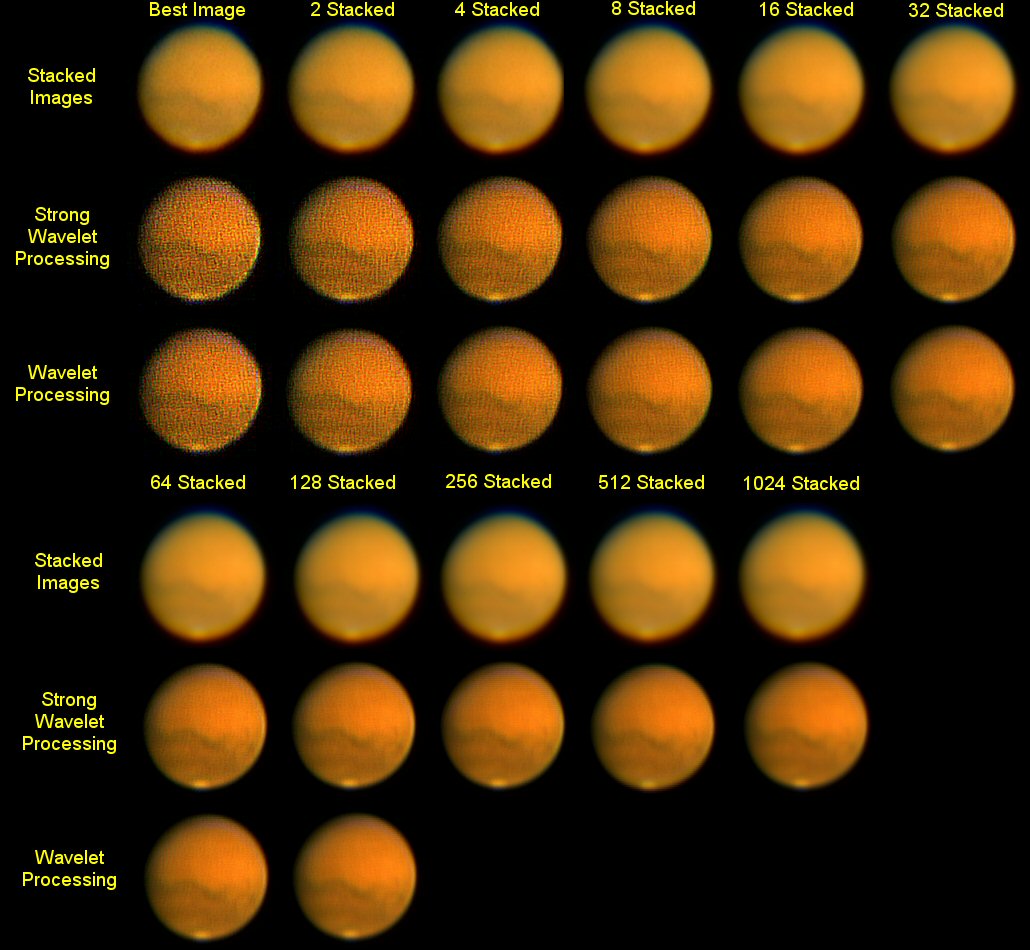
Process RegiStax BMP File with Paint Shop Pro
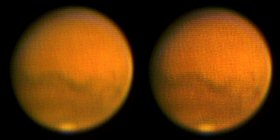 The left Mars image is from RegiStax processing and the right Mars image is the final image after processing with Paint Shop Pro.
The left Mars image is from RegiStax processing and the right Mars image is the final image after processing with Paint Shop Pro.
- Crop image
- Rotate image if needed
- Unsharp Mask
- Use Edge Perserving Smooth if image is too noisy
- Use curves to increase contrast in the dimmer areas
- Use Histogram Adjustment to remove color cast to the black sky
- Resize image smaller if image is too fuzzy
- Save as JPG for web site

© 1998-2007 David Haworth
![]()
![]()





 The left Mars image is from RegiStax processing and the right Mars image is the final image after processing with Paint Shop Pro.
The left Mars image is from RegiStax processing and the right Mars image is the final image after processing with Paint Shop Pro.